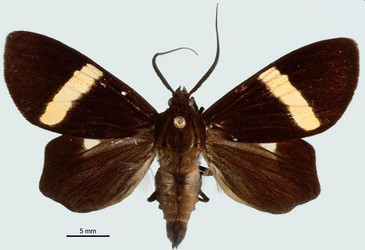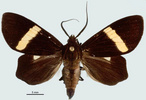Phavaraea
James S. Miller and Andrew V. Z. BrowerIntroduction
A neotropical genus containing the largest members of Josiini. Life history is unrecorded, but the group's close relationship to Getta and Polyptychia suggests that its larvae feed on Passiflora (Astrophea).
Characteristics
Male hindwings of Phavaraea spp., along with those of Polyptychia, exhibit a fold near the anal margin containing a flamboyant tuft of androconial scales. Unlike Polyptychia, however, members of Phavaraea possess "typical" (plesiomorphic) forewing venation (Miller 2009).
References
Miller, JS. 2009. Generic revision of the Dioptinae (Lepidoptera: Noctuoidea: Notodontidae). Bulletin of the American Museum of Natural History 321, 1-971 + 48 plates.
Title Illustrations

| Scientific Name | Phavaraea dilatata |
|---|---|
| Location | Brazil: Río de Janeiro, Lagoa de Saquarema |
| Reference | Miller JS. 2009. Generic revision of the Dioptinae (Lepidoptera: Noctuoidea: Notodontidae). Bulletin of the American Museum of Natural History 321, 1-971 + 48 plates. (Plate 28) |
| Specimen Condition | Dead Specimen |
| Identified By | James S. Miller |
| Sex | Male |
| Life Cycle Stage | adult |
| View | dorsal |
| Collection | BMNH - Oberthür collection |
| Collector | P. Germain |
| Image Use |
 This media file is licensed under the Creative Commons Attribution License - Version 3.0. This media file is licensed under the Creative Commons Attribution License - Version 3.0.
|
| Copyright |
© 2009

|
| Scientific Name | Phavaraea rectangularis |
|---|---|
| Location | French Guiana: Route forestière de Bélizon, Monts Tortue |
| Comments | collected at light |
| Reference | Miller JS. 2009. Generic revision of the Dioptinae (Lepidoptera: Noctuoidea: Notodontidae). Bulletin of the American Museum of Natural History 321, 1-971 + 48 plates. (Plate 28) |
| Specimen Condition | Dead Specimen |
| Identified By | James S. Miller |
| Sex | Male |
| Life Cycle Stage | adult |
| View | dorsal |
| Collection | B. Hermier collection |
| Collector | J.-L. Giuglaris |
| Image Use |
 This media file is licensed under the Creative Commons Attribution License - Version 3.0. This media file is licensed under the Creative Commons Attribution License - Version 3.0.
|
| Copyright |
© 2009

|
About This Page

Middle Tennessee State University, Murfreesboro, Tennessee, USA
Correspondence regarding this page should be directed to James S. Miller at and Andrew V. Z. Brower at
Page copyright © 2010 and
 Page: Tree of Life
Phavaraea .
Authored by
James S. Miller and Andrew V. Z. Brower.
The TEXT of this page is licensed under the
Creative Commons Attribution-NonCommercial License - Version 3.0. Note that images and other media
featured on this page are each governed by their own license, and they may or may not be available
for reuse. Click on an image or a media link to access the media data window, which provides the
relevant licensing information. For the general terms and conditions of ToL material reuse and
redistribution, please see the Tree of Life Copyright
Policies.
Page: Tree of Life
Phavaraea .
Authored by
James S. Miller and Andrew V. Z. Brower.
The TEXT of this page is licensed under the
Creative Commons Attribution-NonCommercial License - Version 3.0. Note that images and other media
featured on this page are each governed by their own license, and they may or may not be available
for reuse. Click on an image or a media link to access the media data window, which provides the
relevant licensing information. For the general terms and conditions of ToL material reuse and
redistribution, please see the Tree of Life Copyright
Policies.
- First online 12 August 2009
- Content changed 12 August 2009
Citing this page:
Miller, James S. and Andrew V. Z. Brower. 2009. Phavaraea . Version 12 August 2009 (under construction). http://tolweb.org/Phavaraea/138579/2009.08.12 in The Tree of Life Web Project, http://tolweb.org/










 Go to quick links
Go to quick search
Go to navigation for this section of the ToL site
Go to detailed links for the ToL site
Go to quick links
Go to quick search
Go to navigation for this section of the ToL site
Go to detailed links for the ToL site